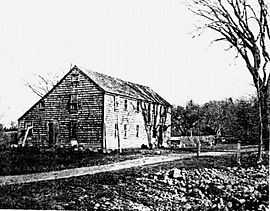Saltbox
A saltbox is a building with a long, pitched roof that slopes down to the back, generally a wooden frame house. A saltbox has just one story in the back and two stories in the front. The flat front and central chimney are recognizable features, but the asymmetry of the unequal sides and the long, low rear roof line are the most distinctive features of a saltbox, which takes its name from its resemblance to a wooden lidded box in which salt was once kept.
Origins

The saltbox originated in New England, and is an example of American colonial architecture. One theory holds that the saltbox form was popularized by Queen Anne's taxation of houses greater than one story. Since the rear of the roof descended to the height of a single-story building, the structure was exempt from the tax.[1][2] More likely, though, the saltbox shape evolved organically from the need for additional space for growing families; adding a lean-to was an economical way to enlarge the house.
The earliest saltbox houses were created when a lean-to addition was added onto the rear of the original house extending the roof line sometimes to less than six feet from ground level. Old weathered clapboards are still in place on parts of the original rear exterior walls of some of the earliest New England saltbox houses (see images). The hand-riven oak clapboards on both the Comfort Starr House and Ephraim Hawley House are preserved in place in the attic that was created when the lean-to was added onto the original house. The style was popular for structures throughout the colonial period and into the early Republic, perhaps because of the simplicity of its design.
Alternatively, Albion's Seed: Four British Folkways in America by David Hackett Fischer traces American Saltbox to East England areas of Kent & East Anglia from the early 1600s.[3]
Saltbox homes can also be found in parts of Newfoundland and Labrador.
Construction

Saltboxes, along with many other types of colonial houses, can be considered to be timber-frame houses. Timber framing, or post-and-beam construction, involves joining large pieces of wood with woodworking joints, such as mortise-and-tenon joints, or with wooden pegs, braces, or trusses. Metal nails were sparingly used, because of their expense. Timber frame construction was the construction method for all frame houses in 17th- and 18th-century America, where the abundance of wood made the timber frame house popular, until the advent of "balloon framing" in the early 1800s. The exterior of a saltbox was often finished with clapboard or other wooden siding. The Josiah Day House in West Springfield, Massachusetts is constructed of brick.[4]
Images
-

Circa 1643 Edmund Rice homestead in Sudbury (now Wayland, Massachusetts), destroyed by fire ca1912
-

Circa 1645 Comfort Starr House, Guilford, Connecticut
-

Side elevation of Circa 1645 Comfort Starr House illustrating the distinctive roof line
-
Circa 1651 Macy-Colby House, Amesbury, Massachusetts
-
Circa 1681 John Adams Birthplace, Quincy, Massachusetts
-
Circa 1670-1690 Ephraim Hawley House, Nichols, Connecticut
-

Circa 1745 Brick Josiah Day House West Springfield, Massachusetts
-

Circa 1838, Sturgeon House, Fairview, Pennsylvania
-

Lindheimer House in New Braunfels, Texas, built in 1852, currently operated by the New Braunfels Conservation Society
See also
References
- ↑ New York Times (1900-12-22). "The Salt-Box House.; Books of the Season.". The New York Times. Retrieved 2008-04-27.
- ↑ "Tax Shelters: The Three-Storey Bungalow". Retrieved 2008-04-27.
- ↑ Albion's Seed: Four British Folkways in America, David Hackett Fischer
- ↑ Joshua Day House Museum website retrieved on 2009-07-19 West-springfield.ma.us
External links
- Saltbox Houses in the Historic American Buildings Survey
- Timber-frame Houses in the Historic American Buildings Survey
- Early Connecticut Houses: An Historical and Architectural Study By Norman Morrison Isham, Albert Frederic Brown
| ||||||||||||||||||||||||||||||
.jpg)


